Leroy C., Rancoita P.-G. Principles Of Radiation Interaction In Matter And Detection
Подождите немного. Документ загружается.

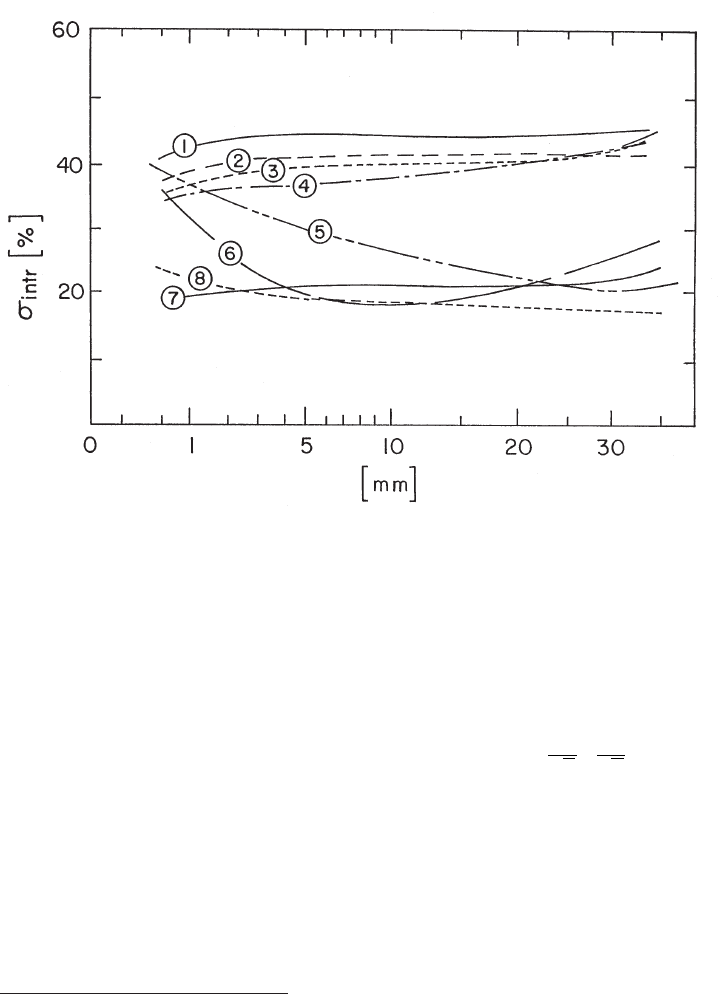
January 9, 2009 10:21 World Scientific Book - 9.75in x 6.5in ws-bo ok975x65˙n˙2nd˙Ed
700 Principles of Radiation Interaction in Matter and Detection
Fig. 9.30 Intrinsic resolutions (σ
intr
) in [%] calculated by means of Monte-Carlo simulations for
different passive and active samplers (namely liquid argon [LAr], scintillator [PMMA] and silicon
detector [Si]) as a function of the passive sampler thickness in mm (from [Leroy and Rancoita
(2000)], see also [Wigmans (1987)] for details). The curves are for: (1) Pb/0.4 mm Si ∼ Pb/2.5 mm
LAr and no neutron capture, (2) Pb/0.4 mm Si ∼ Pb/2.5 mm LAr for 20% neutron capture, (3)
U/0.4 mm Si for 20% neutron capture, (4) U/2.5 mm LAr for 20% neutron capture, (5) Pb/2.5 mm
PMMA, (6) U/2.5 mm PMMA, (7) Fe/0.4 mm Si ∼ Fe/2.5 mm LAr for 20% neutron capture, (8)
Fe/5 mm PMMA.
For an Fe (Pb) sampler with a thickness of 6 mm, one finds ≈
0.30
√
E
³
0.32
√
E
´
.
The intrinsic resolution was also studied with Monte-Carlo simulations
††
and
measured, usually, with compensating or quasi-compensating calorimeters
‡‡
.
In Fig. 9.30, intrinsic resolutions (σ
intr
) from [Leroy and Rancoita (2000)] (see
also [Wigmans (1987)]) are shown for low-A (Fe) and high-A (Pb and U) passive
samplers, some active media, a small percentage of neutron capture and no neutron
capture (see [Wigmans (1987); Leroy and Rancoita (2000)] for details). These results
show that, for non-hydrogeneous active media, the intrinsic resolution is larger
than for hydrogeneous detectors, since the amount of invisible energy is decreased
††
One can see [Amaldi (1981); Brau and Gabriel (1985); Wigmans (1987); Br¨uckmann et al.
(1988); Fesefelt (1988); Wigmans (1988); Brau and Gabriel (1989); Brau, Gabriel and Rancoita
(1989); Wigmans (1991)] and references therein.
‡‡
The reader can see, for instance, [Fabjan et al. (1977); HELIOS Collab. (1987); Tiecke (1989);
Drews et al. (1990); SICAPO Collab. (1995a,b, 1996)] and references therein.

January 9, 2009 10:21 World Scientific Book - 9.75in x 6.5in ws-bo ok975x65˙n˙2nd˙Ed
Principles of Particle Energy Determination 701
when its fluctuation is reduced. As a consequence, compensating calorimeters with
hydrogeneous readout are expected to minimize the contribution from the intrinsic
resolution. However these latter ones (Sect. 9.9.1) require an almost fixed ratio
between passive and active sampler thicknesses.
For non-hydrogeneous readout, the neutron contribution to the overall visible-
energy is small and the estimated intrinsic energy resolutions are
³
σ
E
´
intr
=
σ
intr
√
E
≈
0.2
√
E
for low-A (like Fe) absorbers,
0.4
√
E
high-A (like Pb or U) absorbers.
These values depend weakly on the passive sampler thickness. The intrinsic resolu-
tions, σ
intr
, were determined for low-A and high-A passive samplers (Table 9.9) and
are in agreement with calculated ones shown in Fig. 9.30.
For example, in compensating calorimeters with hydrogeneous readout, i.e., with
a ratio R
p/a
of ≈ 1.2 for U samplers (Sect. 9.9.1), the intrinsic energy resolution is
≈ 0.20/
√
E. An overall energy resolution [HELIOS Collab. (1987)] of ≈ 0.34/
√
E
(Fig. 9.28) was achieved with U samplers, each with a thickness of 2.9% of an intera-
ction length. Also the tuning of the mip ratio allows one to reach the compensating
condition in Pb+Fe calorimeters (Sect. 9.9.2). In this case, the thickness ratio of
the Fe absorber
∗
to the Pb absorber is ≈ 3. The measured intrinsic energy reso-
lution is ≈ 0. 25/
√
E. For an almost-compensating Pb+Fe calorimeter (see Table 1
of [SICAPO Collab. (1996)]), the overall energy resolution achieved is ≈ 0.66/
√
E
(Fig. 9.29) with passive samplers, each with a thickness of 14.3% of an interaction
length. For this type of calorimeter the energy resolution can be improved by de-
creasing the passive sampler thickness (while keeping the Fe to Pb sampler thickness
ratio fixed, see Sect. 9.9.2) to reduce the contribution of the sampling fluctuations
to the overall energy resolution [Eq. (9.78)]. As already discussed, for these com-
pensating (or almost compensating) calorimeters the φ(e/π) term is negligible and
the calorimeter energy resolution scales as 1/
√
E (see Figs. 9.28 and 9.29).
9.10.1
Non-Compensation Effects and the
φ
(
e/π
) Term
The function φ(e/π) in Eq. (9.77) takes into account effects of non-compensation. It
should be emphasized that there exists no analytical expression for the function
φ(e/π), since it depends on several complex processes at the nuclear level, which
are at the basis of the e/π ratio value. This ratio (Sect. 9.8) depends on both the
active and passive samplers. Measured e/π ratios, mostly at the reference energy
of 10 GeV, were given in Sect. 9.9 for different types of calorimeters (for estimated
values based on Monte-Carlo simulations see references cited on page 670). Their
values cover a wide range: ≈ (0.8–1.3).
∗
The contribution of Fe absorbers to the overall intrinsic resolution is lower than the one due to
Pb absorbers.

January 9, 2009 10:21 World Scientific Book - 9.75in x 6.5in ws-bo ok975x65˙n˙2nd˙Ed
702 Principles of Radiation Interaction in Matter and Detection
Table 9.9 Intrinsic resolutions σ
intr
in [%], measured with hydrogeneous media (plastic scintillators) and
non-hydrogeneous media (silicon detectors) from [Leroy and Rancoita (2000)].
Passive Hydrogeneous Non-hydrogeneous Reference
sampler readout [see(1)] readout
Fe (16.2−17.5) [SICAPO Collab. (1995b)]
Fe 19.8±2.4 [SICAPO Collab. (1996)]
Fe+Pb [see(2)] 24.5 [SICAPO Collab. (1995b)]
Fe+Pb [see(2)] 25.9±2.1 [SICAPO Collab. (1996)]
Pb (44.7−48.5) [SICAPO Collab. (1995b)]
Pb 49.9±14.1 [SICAPO Collab. (1996)]
Pb 13.4±4.7 [Drews et al. (1990)]
Pb 11±5 [Tiecke (1989)]
U 47.8±1.9 [SICAPO Collab. (1995a)]
U 20.4±2.4 [Drews et al. (1990)]
U 19±2 [Tiecke (1989)]
U 22 [Fabjan et al. (1977); Fabjan (1985a)]
(1): measured with compensating or almost compensating calorimeters (Sect. 9.9.1).
(2): the ratio of thicknesses between Fe and Pb absorbers makes the calorimeters almost compensating
(Sect. 9.9.2).
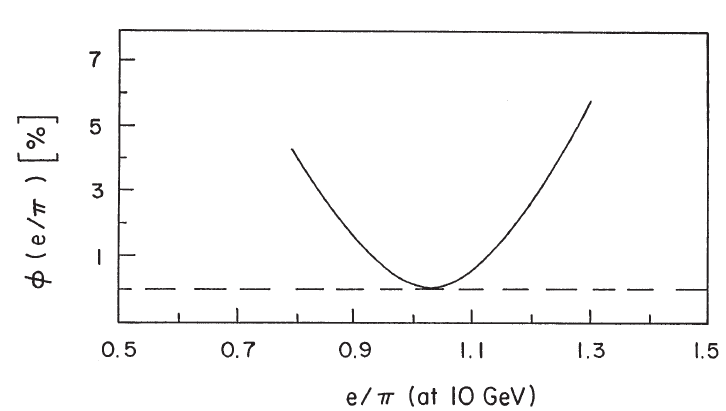
January 9, 2009 10:21 World Scientific Book - 9.75in x 6.5in ws-bo ok975x65˙n˙2nd˙Ed
Principles of Particle Energy Determination 703
The function φ(e/π) vanishes for e/π ∼ 1, i.e., for compensating (or almost
compensating) calorimeters when the equalization of the calorimeter response to
electromagnetic and hadronic cascades is achieved (Sects. 9.8, 9.9). Furthermore, as
discussed so far, φ(e/π) mainly depends on the e/π ratio, but weakly (if at all) on
both the sampling fluctuations and intrinsic resolution of the calorimeter.
The additional term φ(e/π) was estimated using Monte-Carlo simulations by
Wigmans (1987) (see references given in Sect. 9.8, and also, e.g., Section 27.9.2
on Hadronic calorimeters in [PDB (2002)]) as a function of the e/π ratio and of
the incoming hadron energy. These simulations show that φ(e/π) depends slightly
on the incoming hadron energy. As an example, the value φ(e/π), when e/π ratio
is between ≈ (1.11–1.26) at the reference energy of 10 GeV, increases by no more
than ≈ 0.003 in the energy range (10–70) GeV ([SICAPO Collab. (1996)] and also
e.g., [Wigmans (1987)]). From [SICAPO Collab. (1996)] for e/π ratio ≈ 1.11 at
10 GeV, we have φ( e/π) ≈ 0.0094, 0.0101, 0.0104, 0.0109, 0.0115, 0.0122 and 0.0128
at 10, 15, 20, 30, 40, 50 and 70 GeV respectively.
Experimental data on φ(e/π) obtained with calorimeters providing a ratio e/π ∼
1.11 at 10 GeV ([Acosta et al. (1991)], see also [SICAPO Collab. (1995a,b, 1996)] and
references therein) are found to be in agreement with the simulations of [Wigmans
(1987)].
Fig. 9.31 φ(e/π) in [%] is shown as a function of the e/π ratio at the reference energy of 10 GeV
(from [Leroy and Rancoita (2000)]).
In Fig. 9.31, φ(e/π) is shown in percentage (namely multiplied by a factor 100)
as a function of the e/π ratio at the reference energy of 10 GeV. This curve was

January 9, 2009 10:21 World Scientific Book - 9.75in x 6.5in ws-bo ok975x65˙n˙2nd˙Ed
704 Principles of Radiation Interaction in Matter and Detection
obtained by interpolating the simulation results of [Wigmans (1987)]. The function
φ(e/π) is given, within a ≈ 10% approximation, by:
φ(e/π) ≈ −0.207 ln(e/π) − 4.5 × 10
−3
for e/π < 0.955, (9.79)
φ(e/π) ≈ 0.281 ln(e/π) − 2.1 × 10
−2
for e/π > 1.115. (9.80)
For 0.95 < e/π < 1.10, the function φ(e/π) is lower than 0.007 (see Fig. 9.31).
9.10.2 Determination of Effective Intrinsic Resolutions
The energy resolution, σ(E)/E, in non-compensating calorimeters does not scale as
1/
√
E, owing to the non-vanishing term φ(e/π) (Sect. 9.10.1). The overall effect is
to make the parameter C of Eq. (9.77) dependent on the incoming energy. We can
rewrite Eq. (9.77) ([SICAPO Collab. (1995a,b, 1996)] and references therein) as:
σ(E)
E
=
C(E)
√
E
=
q
σ
2
eff
+ σ
2
samp
√
E
, (9.81)
where σ
eff
=
q
C(E)
2
− σ
2
samp
and σ
samp
is given by Eq. (9.78).
The effective intrinsic resolution σ
eff
includes both the effect of the intrinsic
resolution and the effect of non-compensation on the calorimeter energy resolution,
the latter being accounted for by the constant term φ(e/π). Using Eqs. (9.78, 9.77),
the effective intrinsic resolution can be expressed as:
σ
eff
=
q
C(E)
2
− σ
2
samp
(9.82)
=
q
σ
2
intr
+ φ
2
(e/π) E + 2φ(e/π) C
0
√
E. (9.83)
For a compensating calorimeter [i.e., e/π ∼ 1 and φ(e/π) ∼ 0], we get
σ
eff
≡ σ
intr
.
Once the calorimeter energy resolution
h
σ (E)
E
i
was measured, it is possible to eval-
uate C(E) =
h
σ (E)
E
i
√
E and the value of σ
eff
from Eqs. (9.83, 9.77).
The intrinsic resolution [Eq. (9.83)] can be determined from
σ
intr
=
r
h
C(E) − φ(e/π)
√
E
i
2
− σ
2
samp
, (9.84)
where φ(e/π) can be estimated [see Sect. 9.10.1 and references therein, and for
instance Eqs. (9.79, 9.80)], once the e/π ratio of the calorimeter was measured.
In Figs. 9.32, and 9.33, for instance, both σ
intr
[σ
samp
is obtained from Eq. (9.78)]
and σ
eff
[from Eq. (9.83)] are shown for silicon sampling calorimeters using U
(Fig. 9.32) and Fe (Fig. 9.33) passive samplers. For the uranium calorimeter
(Fig. 9.32), σ
eff
was determined as a function of the G10 plate thickness, which are
interleaved in order to achieve the local hardening effect ([SICAPO Collab. (1995a)]
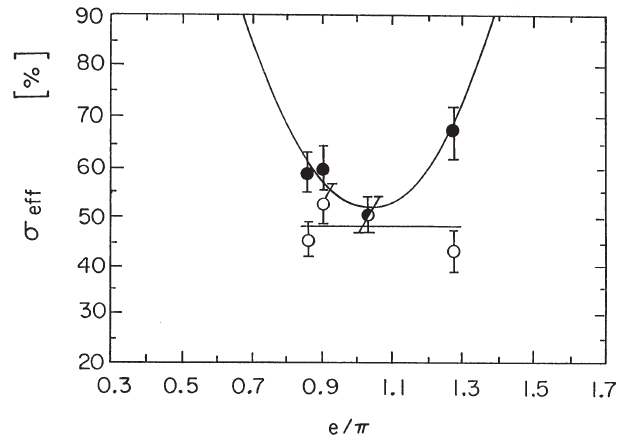
January 9, 2009 10:21 World Scientific Book - 9.75in x 6.5in ws-bo ok975x65˙n˙2nd˙Ed
Principles of Particle Energy Determination 705
Fig. 9.32 σ
eff
(•) in [%] as a function of the e/π ratio in a Si/U sampling calorimeter (reprinted
from Nucl. Instr. and Meth. in Phys. Res. A 361, Furetta, C., Leroy, C., Pensotti, S., Penzo, A.
and Rancoita, P.G., Experimental determination of the intrinsic fluctuations from binding energy
losses in Si/U hadron calorimeters, 149–156, Copyright (1995), with permission from Elsevier; see
also [Leroy and Rancoita (2000)]). The intrinsic energy resolution (◦) are also shown. The e/π ratio
depends on the amount of G10 plates used for the local hardening effect (see also Sect. 9.9.2).
and Sect. 9.9.2). When the e/mip ratio is tuned to achieve the compensation condi-
tion by the local hardening effect, we can observe the effective intrinsic resolution ap-
proaching the intrinsic resolution. For the iron calorimeter (Fig. 9.33), the effective
intrinsic resolution is given as a function of the incoming hadron energy [SICAPO
Collab. (1996)]. σ
eff
increases [Eq. (9.83)] because the constant term φ(e/π) is non
vanishing for non-compensating calorimeters.
From the experimental data, we can observe that the intrinsic resolution is
independent of the incoming energy, as expected. Measured values of intrinsic re-
solutions are given in Table 9.9 (data are from [Fabjan (1985a); HELIOS Collab.
(1987); Tiecke (1989); Drews et al. (1990); SICAPO Collab. (1995a,b, 1996)]).
9.10.3 Effect of Visible-Energy Losses on Calorimeter Energy
Resolution
In Sects. 9.10.1, 9.10.2, the energy resolution of the calorimeter was investigated for
negligible visible-energy losses, i.e., the calorimeter physical sizes are large enough
to almost fully contain the hadronic cascades. However, the energy resolution (as
discussed in Sect. 9.4.2 for electromagnetic showers) is affected by the finite dimen-
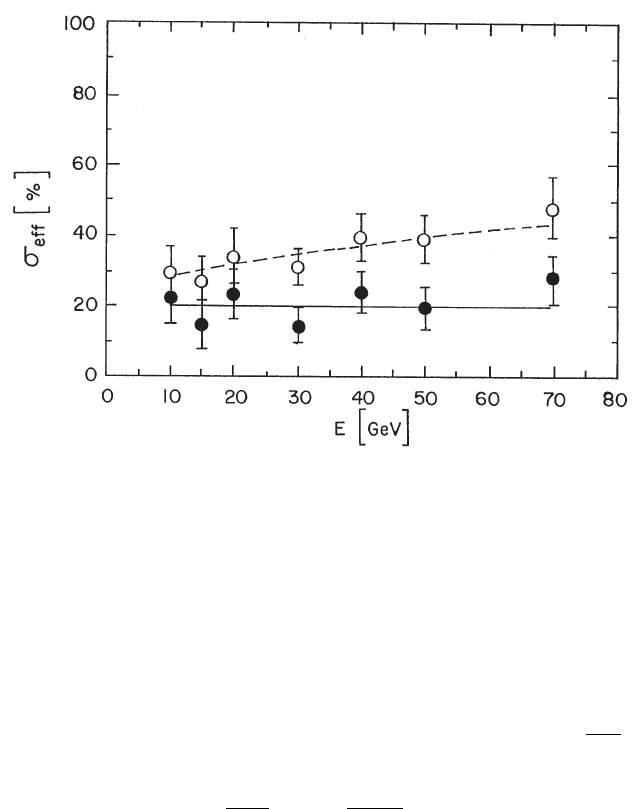
January 9, 2009 10:21 World Scientific Book - 9.75in x 6.5in ws-bo ok975x65˙n˙2nd˙Ed
706 Principles of Radiation Interaction in Matter and Detection
Fig. 9.33 σ
eff
(◦) in [%] in a Si/Fe sampling calorimeter (reprinted from Nucl. Instr. and Meth.
in Phys. Res. A 368, Furetta, C., Gambirasio, A., Lamarche, F., Leroy, C., Pensotti, S., Penzo,
A., Rattaggi, M. and Rancoita, P.G., Determination of intrinsic fluctuations and energy response
of Si/Fe and Si/Fe + Pb calorimeters up to 70 GeV of incoming hadron energy, 378–384, Copyright
(1996), with permission from Elsevier; see also [Leroy and Rancoita (2000)]) as a function of the
incoming hadron energy. The intrinsic energy resolution (•) are also shown.
sions of calorimeters, which can cause leakage of the deposited energy of hadronic
showers. Furthermore in Sect. 9.4.2, we have seen that the limited shower contain-
ment degrades the energy resolution almost linearly with increasing energy-loss.
In a sampling hadron calorimeter, the measured energy resolution
h
σ( E)
E
i
exp
is
given by:
·
σ(E)
E
¸
exp
≡
·
σ(²
vis
)
²
vis
(π)
¸
, (9.85)
where σ(²
vis
) is the standard deviation value of the Gaussian-like distribution of
the hadronic visible-energy, ²
vis
(π), measured in the calorimeter when no correction
for energy losses are included. These losses can be longitudinal, lateral, and dead-
area visible-energy losses (as discussed in Sect. 9.4.2 for electromagnetic calorime-
ters). The latter ones have particularly to be considered for calorimeters with high
granularity, as is the case for silicon readout.
The effects of energy losses on the energy resolution were experimentally mea-
sured. In particular, for hadronic cascades, the linear dependence of the hadronic
resolution on lateral and longitudinal energy-losses was observed up to energy losses
of about 15% [Amaldi (1981)] (see Fig. 9.34). To a first approximation (for energy
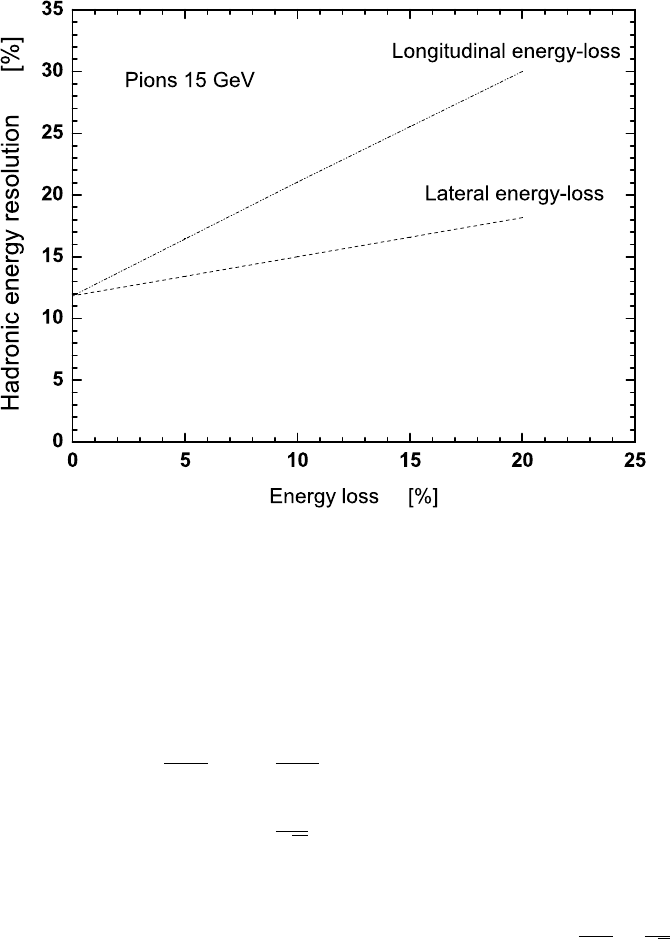
January 9, 2009 10:21 World Scientific Book - 9.75in x 6.5in ws-bo ok975x65˙n˙2nd˙Ed
Principles of Particle Energy Determination 707
Fig. 9.34 Hadronic energy resolution, σ(E)/E in [%], measured as a function of the fraction in
[%] of lateral and longitudinal deposited-energy losses (curves from [Amaldi (1981)], see also [Leroy
and Rancoita (2000)]) for the marble calorimeter of CHARM Collaboration [Diddens et al. (1980)].
losses up to 15%), the combined effect of the overall energy lost on the measured
energy resolution can be expressed, following the discussion in [Amaldi (1981);
SICAPO Collab. (1995b)] (and references therein), according to
·
σ(E)
E
¸
exp
≈
σ(E)
E
"
1 +
X
P
(λ
P
P )
#
=
C
√
E
"
1 +
X
P
(λ
P
P )
#
, (9.86)
where P is the fraction in % of lateral (E
l
), longitudinal (E
L
) and dead area (E
D
)
energy losses to the total visible-energy; λ
P
is a coefficient depending on the kind of
energy lost (namely, lateral, longitudinal or dead area energy-loss); and
σ( E)
E
=
C
√
E
is the expected calorimeter energy resolution in absence of visible-energy losses, i.e.,
the one referred to in Eq. (9.77).
In Fig. 9.34 (see discussion in [Amaldi (1981); Leroy and Rancoita (2000)]), we
can observe that fluctuations produced by lateral energy-losses are less effective,
by a factor ≈ (2–3), than longitudinal energy-losses, as in the case of electromag-

January 9, 2009 10:21 World Scientific Book - 9.75in x 6.5in ws-bo ok975x65˙n˙2nd˙Ed
708 Principles of Radiation Interaction in Matter and Detection
netic showers (Sect. 9.4.2 and references therein), i.e., λ(E
l
) < λ(E
L
). Furthermore,
it was also shown [SICAPO Collab. (1994a)] that the longitudinal energy-losses
are as effective as the dead area energy-losses, i.e., λ(E
L
) ≈ λ(E
D
), since both
of them are related to event-to-event fluctuations. The experimental data allowed
Amaldi (1981) to determine the curves shown in Fig. 9.34, from which one can
derive that, for hadronic cascades, the values of λ
l
and λ(E
L
) ≈ λ(E
D
) are 0.027
and 0.077, respectively.
9.11 Calorimetry at Very High Energy
9.11.1 General Considerations
The concept of cascade and its propagation in matter were studied in previous sec-
tions at the energy range obtainable at particle accelerators. This section turns to
the study of the cascade behavior in an energy regime beyond accelerator energies,
such as the energies characterizing cosmic rays in a band from about 10
8
up to about
10
20
eV, with a flux of particles decreasing rapidly with the increase of the energy. A
considerable number of excellent articles and books have been published over the
years covering the topic of cosmic ray physics and related subjects (see for in-
stance [Greisen (1960); Berezinskii, Bulanov, Dogiel, Ginzburg and Ptuskin (1990);
Knapp et al. (2003); Allard, Parizot and Olinto (2007); Matthiae (2008)]). The aim
of this section is rather to discuss the physics of cascading processes relevant to
cosmic rays
††
.
From our point of view, cosmic rays are subatomic particles and nuclei (helium,
carbon, nitrogen, oxygen up to iron), which hit the Earth’s atmosphere. Primary
cosmic rays, which are particles (such as electrons, protons, helium nuclei and nuclei
synthesized in stars) accelerated at astrophysical sources, are distinguished from
secondary cosmic rays produced by the interaction of primaries with the interstellar
matter (the same cosmic rays can be considered as a part of the interstellar medium,
see [McCray and Snow (1981); Berezinskii, Bulanov, Dogiel, Ginzburg and Ptuskin
(1990)] and references therein). This distinction is not strict. While most of the
observed electrons and protons are believed to be of primary origin, positrons and
antiprotons are generally considered to be secondaries. However, there exists the
possibility that a fraction of the observed positrons and antiprotons is of primary
origin. For instance, the measurement of the energy spectrum of cosmic antiprotons
provides important information on cosmic ray propagation models and might be
sensitive to possible novel processes such as the annihilation of supersymmetric
weakly interacting massive neutral particles, called neutralinos, or the evaporation
of primordial black holes (e.g., see [AMS Collab. (1999)]).
Antiprotons, which are produced by collisions of cosmic rays with the interstellar
††
For a general introduction to cosmic rays and trapped particle in the Earth magnetosphere, the
reader may see Sects. 4.1.2.4 and 4.1.2.5.

January 9, 2009 10:21 World Scientific Book - 9.75in x 6.5in ws-bo ok975x65˙n˙2nd˙Ed
Principles of Particle Energy Determination 709
medium, suffer a kinematical suppression and will show a characteristic energy spec-
trum at kinetic energies below 1 GeV, which falls off towards lower energies. There-
fore, the antiprotons primarily produced by novel processes are predicted to emerge
at these low energies (see, for example, [Jungman and Kamionkowski (1994)] for
antiproton spectra from neutralino masses of 30 and 60 GeV/c
2
). In Fig. 9.35, Local
Interstellar energy Spectra (LIS) of antiprotons from different production models
from [Webber and Potgieter (1989); Simon and Heinbach (1996); Gaisser and Schae-
fer (1997)] are shown. These models differ by the choice of main parameters and
their estimated values (see, for example, [Boella et al. (1998)] for a discussion on
these production models).
However for observations close to the Earth, it has to be considered that the
Sun emits a plasma wind with an embedded magnetic field (Sect. 4.1.2.1), which
may prevent the propagation of low energy cosmic ray particles inside the helio-
sphere. Furthermore in the heliosphere, interactions with particles coming from the
Sun generate an adiabatic process of energy loss for the incoming cosmic rays. Thus,
the LIS spectra are largely modified, particularly for energies up to a few GeV’s. The
effect of solar modulation depends on solar activity (Sect. 4.1.2.3) and results in a
time dependence of the interstellar energy spectra at the Earth orbit (Fig. 9.36, see
also [Boella et al. (1998)]).
The exact origin of cosmic rays is presently unknown. Charged particles which
dominate (> 99.9%) hadronic cosmic radiation cannot be tracked back to their
origin, since they are deflected by the weak galactic magnetic field and, then, the
reach Earth uniformly. Therefore, high energy photons serve an important role,
when one tries to find the origin of cosmic rays. Since they are uncharged and reach
the Earth undeflected by the galactic magnetic field, their possible detection can
lead to the identification of their source.
At present, data exist (see, for example, [Werber et al. (1991); Simpson (1983)])
on the energy spectra of various particles and nuclei from hydrogen to iron with
kinetic energies of up to hundreds of GeV per nucleon (Fig. 9.37). The fraction of
secondary nuclei in the cosmic rays decreases with the increase of the energy. Direct
measurements of the intensity of protons and helium nuclei give energies
¶
of the
order of 3 × 10
5
GeV/nucleon. For energies beyond 10
5
GeV, the spectra consist
almost exclusively of data from the measurements of extended air showers. Between
10 and 10
6
GeV, the full cosmic ray spectrum is described by a power law as a
function of the particle (kinetic-) energy [Yodh (1987)]:
dN
f
dE
∝ E
−γ
p
, (9.87)
where γ
p
≈ 2.7 (see, for instance, Sect. 4.1.2.4; [Berezinskii, Bulanov, Dogiel,
Ginzburg and Ptuskin (1990); Gaisser (1990)] and references therein). Possible dif-
ferential galactic spectra (i.e., with slightly different γ
p
values
‡‡
) were observed for
protons and helium nuclei [Randall and Van Allen (1986); AMS Collab. (2002)].
¶
The reader can find the definition of kinetic energies per nucleon in Sect. 1.4.1.
‡‡
γ
p
is the differential spectral index see page 332.
